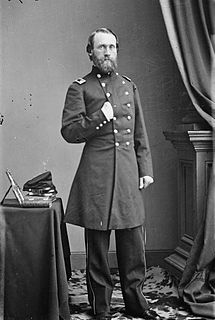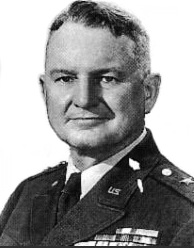
The Secretary of War was a member of the United States President's Cabinet, beginning with George Washington's administration. A similar position, called either "Secretary at War" or "Secretary of War", had been appointed to serve the Congress of the Confederation under the Articles of Confederation between 1781 and 1789. Benjamin Lincoln and later Henry Knox held the position. When Washington was inaugurated as the first president under the Constitution, he appointed Knox to continue serving as Secretary of War.

The Chief of Staff of the Army (CSA) is a statutory office held by a four-star general in the United States Army. As the most senior uniformed officer assigned to serve in the Department of the Army, the CSA is the principal military advisor and a deputy to the Secretary of the Army. In a separate capacity, the CSA is a member of the Joint Chiefs of Staff and, thereby, a military advisor to the National Security Council, the Secretary of Defense, and the President of the United States. The CSA is typically the highest-ranking officer on active-duty in the U.S. Army unless the Chairman or the Vice Chairman of the Joint Chiefs of Staff are Army officers.

Prior to the institution of the Chief of Staff of the Army in 1903, there was generally recognized to be a single senior-most officer in the United States Army, even though there was not a statutory office as such. During the American Revolutionary War (1775–1783), the title was Commander-in-Chief of the Continental Army. In 1783, the title was simplified to Senior Officer of the United States Army. In 1821, the title was changed to Commanding General of the United States Army. The office was often referred to by various other titles, such as "Major General Commanding the Army" or "General-in-Chief."

The North Carolina Army National Guard is North Carolina's principal military force. The force is equipped by the federal government and jointly maintained subject to the call of either. The professional head of the North Carolina Army National Guard is the Adjutant General.

Roger Jones served as Inspector General of the U.S. Army from 1888 to 1889. His father by the same name served as Adjutant General of the U.S. Army from 1825 to 1852.

Henry Pinckney McCain was an officer in the United States Army who served as Adjutant General of the U.S. Army from 1914 to 1918.

Thomas Humphrey Cushing was an officer in the Continental Army, and later the United States Army, and finally became a collector of customs for the port of New London, Connecticut.
Abimael Youngs Nicoll was an officer in the United States Army who served as Adjutant General and acting Inspector General of the U.S. Army from 1807 to 1812.
Morgan Connor was an officer in the Continental Army who served as Adjutant General in 1777.
Henry De Butts was an officer in the United States Army who served as acting Adjutant General and acting Inspector General of the U.S. Army from 1792 to 1793.
Michael Rudolph (1758–1795), an officer in the United States Army, served as acting Adjutant General and acting Inspector General of the U.S. Army in 1793.
Edward Butler was an officer in the United States Army who served as acting Adjutant General and acting Inspector General of the U.S. Army from 1793 to 1794 and from 1796 to 1797.
Jonathan Haskell was an officer in the United States Army who served as acting Adjutant General and acting Inspector General of the U.S. Army in 1796. After the war he returned to farm in Belpre, Ohio.

John Pratt was an officer in the United States Army who served as acting Adjutant General of the U.S. Army from 1790 to 1791.

David Ayres Depue Ogden was a United States Army Lieutenant General. He was noteworthy for his command of the 3rd Engineer Special Brigade during World War II, the Ryukyus Command in the early 1950s, and his culminating assignment as the US Army's Inspector General.

Walter Lawrence Reed was a Major General in the United States Army who served as Inspector General of the Army from December 1, 1935 to December 23, 1939. His father was Army Medical Corps officer Major Walter Reed, namesake of the Walter Reed Army Medical Center. Major General Reed died in the Walter Reed Army Medical Center.

The Office of the Inspector General of the United States Army (OTIG) serves to "provide impartial, objective and unbiased advice and oversight to the army through relevant, timely and thorough inspection, assistance, investigations, and training". The position of Inspector General (IG) has existed since 1777, when Thomas Conway was appointed, and the office has been reorganized many times, varied in size dramatically, and nearly abolished on several occasions. In its early days, the inspectorate was frequently merged with, or proposed to be part of, the Adjutant General's department. It expanded greatly after the American Civil War, to the point that it had around 2,000 officers in 1993.

The Office of the Inspector General(OTIG) serves to "provide impartial, objective and unbiased advice and oversight to the Army through relevant, timely and thorough inspection, assistance, investigations, and training." The position has existed since 1777, when Thomas Conway was appointed the first inspector. The department was reorganized many times, and almost abolished on several occasions. In its early days, the department was frequently merged with, or proposed to be part of the Adjutant General. It expanded greatly after the American Civil War, to the point that it had around 2,000 officers in 1993. The current holder of the position is Leslie C. Smith.

Washington, D.C., formally the District of Columbia and commonly referred to as Washington or D.C., is the capital of the United States. Founded after the American Revolution as the seat of government of the newly independent country, Washington was named after George Washington, first President of the United States and Founding Father. As the seat of the United States federal government and several international organizations, Washington is an important world political capital. The city is also one of the most visited cities in the world, with more than 20 million tourists annually.
The United States Government Publishing Office (GPO) is an agency of the legislative branch of the United States federal government. The office produces and distributes information products and services for all three branches of the Federal Government, including U.S. passports for the Department of State as well as the official publications of the Supreme Court, the Congress, the Executive Office of the President, executive departments, and independent agencies.

Lanham is an unincorporated community and census-designated place in Prince George's County, Maryland. As of the 2010 United States Census it had a population of 10,157. The New Carrollton station as well as an Amtrak station are across the Capital Beltway in New Carrollton, Maryland. Doctors Community Hospital is located in Lanham.













